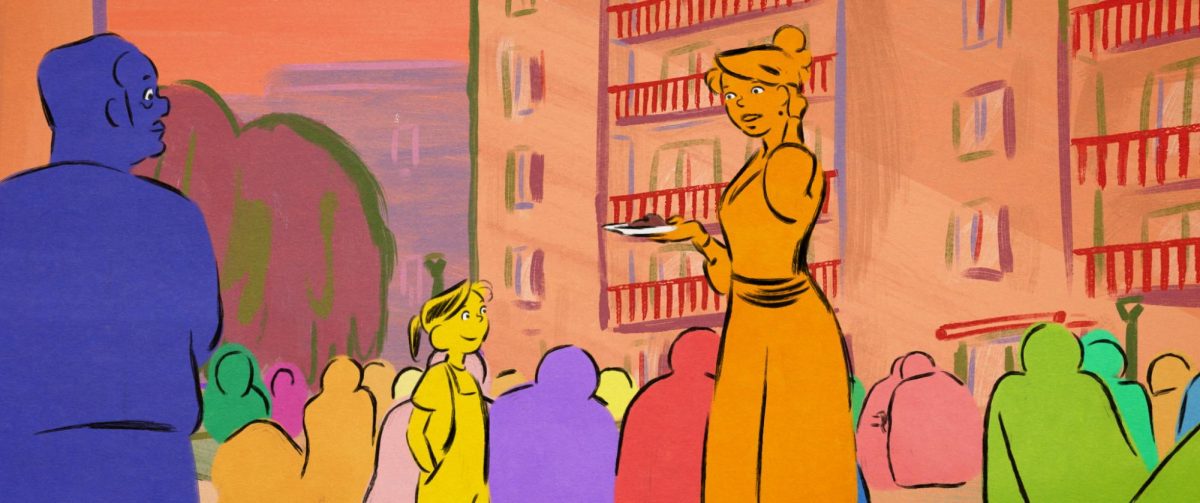Linda glows yellow, her mother Paulette orange, her aunt Astrid pink and her cat Gazza purple. Peaking through the windows of a tall building in the middle of a picturesque French community, Linda’s friends add up to all the colors in the rainbow.
In a brightly lit world, Linda questions the idea of darkness. After losing her father, Guilio, as a young child, Linda is left wondering what could be of a father she can not remember. If she cannot see an image of him in her mind, she wonders what — if anything — he sees in the beyond. To fill the dark gaps of all that is unremembered in her mind, she clings to any tangible reminder of her father.
Linda is enthralled by her mother’s wedding ring. She often tries to convince her mother to let her wear it—and sneaks it on anyway when the answer is “no.” When the ring goes missing one day, Paulette has every reason to blame her unrelentingly sneaky daughter.
Later, discovering that their cat swallowed the ring, Paulette’s guilt over her false accusations—and perhaps over-the-top punishment—leads her to promise she will do whatever it takes to make it up to Linda. Without a second thought, Linda knows what she wants: chicken and peppers—her dad’s special recipe!
While it seems simple enough, Paulette is what you call culinarily challenged. Already disadvantaged, Linda’s meal will occur on the day of a general city-wide strike (oh, France!), leaving every supermarket—and opportunity to buy said chicken—closed. Desperate to make good on her promise, Paulette will go to obscene lengths to get her daughter that chicken.
As a group of colorful characters becomes intertwined in the pair’s misadventures, Linda’s chicken soon becomes the talk of the town. With a buffoonish police officer, the slacker son of farmers, an overbearing older sister, a romantic truck driver and his mother and a town flooded with strike-excited children, the movie goes to show that nothing brings a group together like food.
Director duo Chiara Malta and Sébastien Laudenbach bring to screen a heart-warming, often humorous, semi-musical exploration of grief, family roles and community. Often, when children’s movies are motivated to create learning opportunities and meaningful messages, it is painfully apparent that there is no other goal. The simplicity of dimension is what makes it a movie for children. “Chicken for Linda!” brings you its message, not on a silver platter.
Entirely hand-painted, I have not seen such a visually unique child-oriented animation in ages. As animation progresses rapidly, it is not uncommon for me to be in awe of the medium, but choosing such a bold art style in a children’s movie was a joy often missed. Often aiming to be realistic, animation frequently falls short of expressive creativity on a large scale. While it is a genre primarily targeted at children, whose imaginations will likely allow them to accept more than a standard, ultra-realistic image, our screens should more frequently be splattered with unpolished color.
With color-coded characters, the filmmakers could get away with looser depictions of their physicality, sometimes appearing as just a splatted blob of paint. In a story that explores how loosely defined the act of grief is, the blurring of individuals works to expand the sentiment.
The childlike sense of wonder was just as present in a theater filled with only adults as if I had been sitting among toddlers. Though it was clear that the intention was for this to be a family film, made to captivate younger audiences, it was one of the more touching movies I have had the chance to experience this last year. A good film knows its audience. A great film is for everyone.
This delicious film has a recipe sure to satisfy the hunger of any audience. Stuffed with laughter and tears, it reminds us that mothers and daughters are not too different from one another, both getting a taste of life for the first time.

















































































